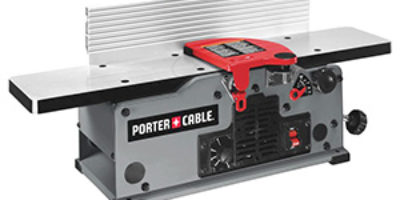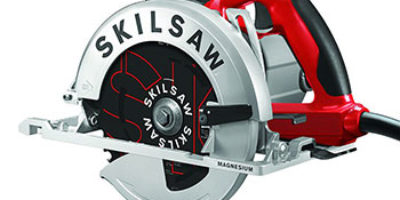We may receive a commission for products purchased through the links on our site at NO additional cost to you.
Did you know that a wood router has replaced so many hand tools in a workshop? The best wood router has enhanced the woodworking of all of those who do woodworking for a career, a side job, or even a hobby. Wood routers can do a variety of different things such as edging, trimming, cutting patterns, and so much more. Using a router tool can cut the time tremendously when it comes to all of these tasks. We have explored the best woodworking routers from the most reliable brands through many wood router reviews. Knowing the different types of routers and what they have to offer is the best place to start.
Best Woodworking Router Reviews – The Top Ten
[go_pricing id=”best_routers1″]To see the complete top ten wood router comparison table, reviews, and buying guide, scroll for more.
1. Bosch 1617EVSPK Fixed & Plunge Router
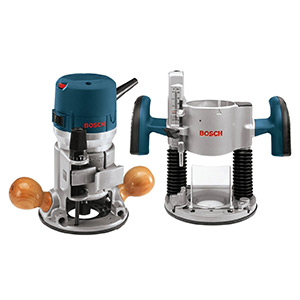
A router combo with a soft start and a variable speed motor that allows you to set the optimal speed. Has a powerful 12 amp motor with 2.25 horsepower with a speed range of 8,000 and up to 25,000 RPM.
The router itself is very durable, made from hard plastic and aluminum. Features wooden handles on the fixed base and soft grip handles on the plunge base. With a 2 inch base openings allowing for better visibility.
The collets are in a wide range, it can handle larger and smaller collets, ¼ inch and ½ inch. The diameter of the fixed base is 6 inches and for the plunge base is 6 11/16 inches.
It weighs 10 pounds making it convenient to transport throughout the workshop or to different work sites and it can be mounted to a table as well. Not to mention, it comes with a rugged carrying case.
Pros:
- Best plunge and fixed base router combo, quick and easy adjustments regardless of which base is used with smooth plunge action.
- A centered bit design with the sub-base or the optional guides. It allows you to glide along the cutting line using dovetail fixtures, jigs, or other template guides.
- Self releasing collet chucks with double wrench locking system, collets can be grabbed tightly where a spindle lock cannot provide that security.
- Microfine bit-depth adjustment on both bases, with a range of one inch and accuracy of 1/64 inch, providing fast and accurate changes.
- The built-in constant response circuitry stabilizes the start-up torque and maintains a constant speed throughout the cut.
Cons:
- Changing between the bases is difficult. It gets stuck and scratches the router. However, using some wax may solve this problem.
- Fine depth adjustment is a bit wobbly, especially when mounted on a router table.
2. Dewalt DWP611PK Compact Router
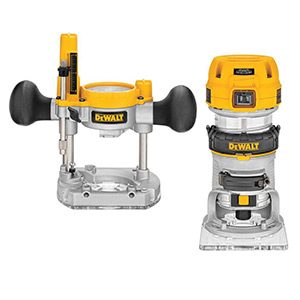
A 7 amp interchangeable router that can be a attached to a plunge base or used freely. Uses a 1.25 HP motor with variable speed control that runs at 16,000 to 27,000 RPM. Features a soft start motor, clear sub base, and dual LED lights.
Has 5 depth stops and an adjustable rod that allows precise control of the depth settings when utilizing the plunge base. Bit depth travel range is 1 ½ inches when used with the standard base and 2 inches when used with the plunge base.
Runs on 120 volts and uses only ¼ inch collets. Equipped with a sturdy aluminum motor housing. Very lightweight, weighs around 6 pounds, easily transferable to different locations and throughout the workshop. A great wood routers for small workshops.
Pros:
- Best compact router with soft-start and full electronic feedback, keeping a constant motor speed throughout the cut.
- Fine-tune bit control for the fixed base within 1/64 of an inch.
- Perfect placement of LED lights and clear sub-base for optimal visibility during woodworking.
- Easily adjustable plunge base with lever switch. The changeover from plunge base to fixed base is simple and quick.
- Spindle lock for bit changes with a single wrench reduces stripped parts by not utilizing allen head bolts like many other power tools.
Cons:
- Overheats and can melt bushings when used for extended periods of time.
- Spindle lock bit change can be difficult for those without much arm strength.
3. Makita XTR01Z Cordless Router
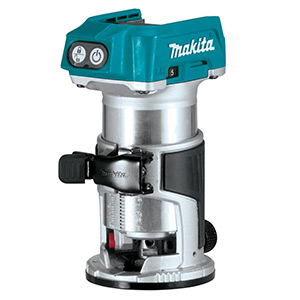
A cordless router with a brushless sturdy motor allowing for more than half of the operating time, more speed, more power, and longer life of the tool. The variable speed control will let it work from 10,000 to 30,000 RPM.
The soft start and electronic speed control will allow you to keep the same speed for greater accuracy and easier start up. The router features two LED lights to help you see the surface you are working on. It is also cordless allowing it to be taken anywhere and weighs less than 5 pounds for even more convenience.
It uses ¼ and ⅜ inch collets and has a shaft lock for easy and fast bit changes. The depth adjustment is easily controlled with the quick release lock system. Additional bases can be purchased separately to allow for versatility on any project.
Pros:
- Best cordless router, for such a small router it can do many of the big tasks without putting any strain on the motor.
- Aluminum housing and ergonomic design with a powerful brushless motor, it runs fairly quiet compared to most models.
- It’s compatible 5 amp-hour battery allows it to deliver 380 feet of cutting operation on red oak, allowing you to work freely with no cords on the way.
- The dust collector works exceptionally well and does not have much dust that escapes.
- Dual lights are great for any tool, especially this one when you are making cuts that are hard to visualize until after they have been made.
Cons:
- The opening on the sub base is rather small and using larger bits is not an option as they won’t fit through the hole.
- The depth adjustment could be a little tighter to ensure full accuracy.
4. Porter Cable 892 Wood Router
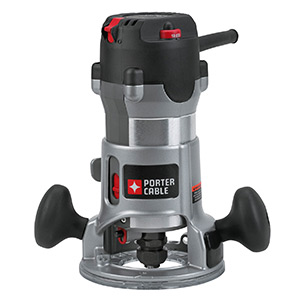
A fixed base router system allowing it to be attached to a router table. It runs on 10,000 to 23,000 RPM, powered by a 2.25 horsepower motor that runs quietly which is great for workshops and work sites.
Runs on a 12 amp motor, equipped with soft start that allows you to build up speed for precision cutting. Further, it has a quick change bit system with one wrench tool making it easy for even the beginner to change out the bits. It has dual position on the handles that will allow you to control the power of the router while you are operating.
A portable router, weighing in at just over 9 pounds. It uses both the ¼ inch and ½ inch collets allowing for more versatility in projects. Not to mention, it comes with everything you will need to start working with a carrying case for easy portability.
Pros:
- Best fixed base router, it can easily be connected to a router table with great speed control allowing for quick bit change and height adjustment.
- The safety mechanism is great when using it as a handheld router as well.
- Easily operate the power switch while still holding on to both handles.
- Fine depth adjustment settings to 1/128 of an inch.
- A powerful motor, does not heat up after prolonged use.
Cons:
- Safety mechanism resets itself after every stop which is not ideal if it is being used on a router table rather than as a hand held router. You would have to reach under the table after each stop in order to reset the safety.
- The push button lever that controls the bit height leads to inaccuracies. It has about ⅛ inch play rather than utilizing a screw type locking mechanism which would keep everything tight.
5. Triton TRA001 Plunge Base Router
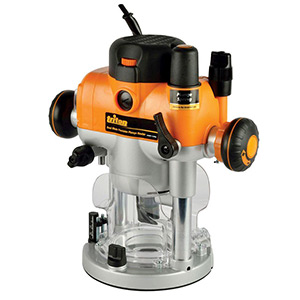
A 15 amp plunge router with one of the most powerful router motors in our list. It allows it to run between 8,000 to 21,000 RPM. Features a quick change bit adjustment that only requires one wrench, a soft start motor, and variable speed control allowing for the greatest accuracy.
It has some great safety features such as the safety switch shutter that locks the power off when changing bits. The motor retains less dust due to the side air vents. It can use both ¼ inch collets and ½ inch collets to allow versatility with most projects.
It runs at 3.25 horsepower. Weighing in at almost 13 pounds, it is easily transported in the workshop or work site. The cast iron table allows for the most durability and a longer lasting router. With its oscillating action, there is less damage to the project from chips and burns.
Pros:
- Best plunge router, it is very easy to adjust as well as set up with a multi-function fence delivering optimum control for circle cutting and hand-held use.
- Full electronic speed control guarantees a superior finish on different woods.
- Fine adjustments make cuts easier and more precise for all projects.
- A 3-stage turret equipped with direct reading scales for accurate cutting depth settings.
- Changing out bits is quick and easy with an automatic spindle lock.
Cons:
- The adjustment knob and spring is too weak.
- Dust collection system is oddly placed and difficult to match with the proper hose without taking it in somewhere to have it professionally matched.
6. Bosch PR20EVS Colt Palm Router
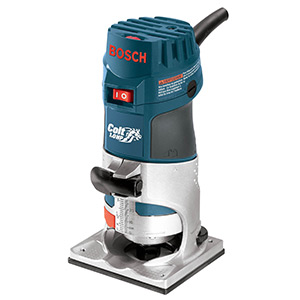
This router tool features 1 HP and 5.6 amps motor. It has a variable speed control that reaches 16,000 to 35,000 RPM. Can fit bits as large as 1 5/16 inch with a fast bit changing system.
The guide is a straight edge allowing for straighter cuts directly on the edge or 3 ⅝ inches away. The cord is only 10 inches long, however, it is angled away from the router to keep it out of the way.
Has an aluminum housing for the fixed base for added durability. Featuring finger support pockets to allow maximum control, safety, and stability for all projects, including edge trimming. Depth adjustment systems handles for micro and macro adjustments.
Weighing in at a little over 3 pounds, it can be easily transported as well as controlled. Operates at 120 volts and fits ¼ inch collet bits.
Pros:
- Best palm router, being small and lightweight makes operating this router very easy.
- Has a soft start circuitry to reduce the torque movements on startup and response circuitry to maintain an optimum speed matching the selected RPM.
- Can be operated with one hand allowing the other hand access to the lock system.
- Bit change is quick and easy with a spindle lock and one wrench or by using the manual two wrenches method.
- Easy base changes with a shaft lock that ensures the base is on correctly and stays on throughout the use until the next base change.
Cons:
- The grip and the vibrations with this router is not suitable for people with trouble with their hands such as having arthritis.
- The degree gauge is difficult to read as it is stamped in black, the same color as the base. This can be fixed by applying white out to the lettering so that it stands out.
7. Dewalt DW618B3 Plunge & Fixed Base Router
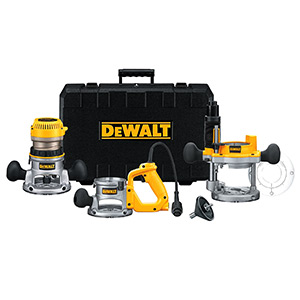
An interchangeable router that has both a plunge base and a fixed base. Runs at 2.25 HP. Has a 12 amp variable speed motor, perfect for hardwoods. Speed control at 8,000 to 24,000 RPM and has a soft start for maximum control.
Features a rubber covered handles for great comfort and balance. With a trigger switch in the D-handle that can lock-on. The plunge stroke is 2 ½ inch. The micro-fine depth can be adjusted within 1/64 of an inch and has 5 level adjusted turret stops.
The tool itself weighs a little over 10 pounds, it can be transported throughout the workshop as well as to different job sites. It can fit ½ inch router bits or be changed out to accommodate ¼ inch router bits. In addition, the dust collection system collects at least 95% of the dust put out by this router.
Pros:
- Best interchangeable router, it’s multi-functional with 3 different base types allows for maximum use in all woodworking projects.
- Variable speed allows for working with different bits and more stability and control with different bit sizes.
- Nickel plated base and motor housing for added durability with low weight.
- Has quite a lot of power, however, it is not a loud tool.
- Comes with a hard case that holds everything for all 3 bases and the router, making transportation easier.
Cons:
- Trigger on D-handle is rather stiff and uncomfortable making it difficult to use for extended periods of time.
- Swapping base plates is not ideal when swapping bits and routers. Would be much easier to use if the base plate was versatile.
8. Hitachi KM12VC Fixed & Plunge Router
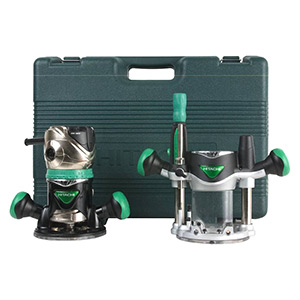
This wood router combo runs on 11 amp power and a motor peak of 2.25 horsepower. The motor features a 2 stage release clamp allowing for quick changes between bases and depth adjustment. The speed is controlled electronically so you can maintain a steady speed of the RPM throughout the cut.
It features a variable speed motor that runs between 8,000 to 24,000 RPM. The wood router can accept both ¼ inch and ½ inch collets. It comes with everything you need including template guides, collets, wrenches, and a carrying case.
One great benefit to this router tool is that it is made to work quietly with the maximum decibels being 79.5 dB. It is light weight with less than 10 pounds making it easy to transport around the workshop or job site.
Pros:
- Best router tool, it can be easily connected to a router table for more stability.
- The handles provide a good grip with the wrapping. It is made of Elastomer compound which helps prevent slipping and reduce vibration.
- Has a plunge stroke of 2.6 inches. It’s a good option for more experienced woodworkers.
- A knob for fine-depth control helps in making precise depth adjustments.
- Has a 5 year warranty which proves the trust the manufacturer has for this product.
Cons:
- The collets tend to get stuck and it’s difficult to switch between bases.
- The plunge action on this router is weak.
9. Festool OF 1400 EQ Woodworking Router
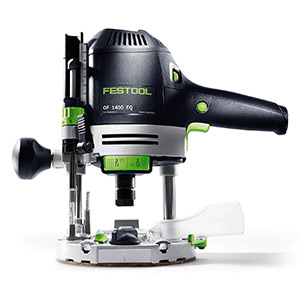
The ergonomic handles allow for the greatest control over this router. The switches are integrated perfectly to allow for one handed operation. It has a 12 amp motor that runs at 120 volts and packs 1400 watts of power.
Having the swivel chip deflector allows this router to be used with several different types of bits, especially edge forming bits to make the corners and curves perfect. The router can use both ¼ inch and ½ inch and 8 mm bits.
It weighs in at less than 10 pounds. This plunge router has a dust extraction port to collect all debris and increase visibility. Safety is also taken care of with a quick-acting brake.
It also have a self centering template guide bushings, you can purchase separately the guide rail system and templates to allow for this to be the ultimate complete routing tool.
Pros:
- Best plunge base router, has 2.25 horsepower motor that provides a speed of 10,000 to 22,500 RPM. With constant electronic speed control system for improved cutting quality under load.
- It is simple to use and provides great accuracy in any project.
- Has plunge depth of 2 ¾ inch with a dial for micro depth adjustment to 1/256 inch.
- Adjustable three position depth stop turret.
- Bit change is incredibly easy with the ratchet head.
Cons:
- The visibility is not great with this router tool specially that it has no LED lights.
- Carries a high price tag compared to other wood routers.
10. Ryobi P601 One+ Trim Router
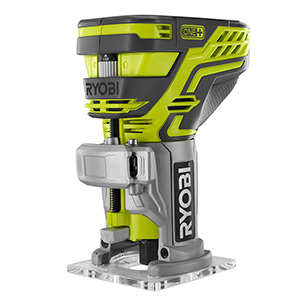
This trim router runs at a top speed of 29,000 RPM. The cordless feature allows it to go virtually anywhere and be used for any number of projects. The handles are coated with an easy grip rubber coating allowing for maximum control, quick and easy bit changes, and precision cutting.
The router features an onboard knob that turns changing bits into a tool-less operation. The markings on the router can assist you in achieving the exact depth for your bit. It works with ¼ inch bits and runs on an 18 volt battery (sold separately).
The LED lights will help you to see your project as you are cutting no matter the lighting conditions are while you work. Weighing in at less than 3 pounds, this is one of the lightest routers in the market and can be transported easily as well as used simply by anyone.
Pros:
- Best trim router even though the router works off of a battery pack, it has great power and precision.
- Owning power tools in the One+ line allows you to interchange the batteries.
- On one charge it is capable of cutting over 600 linear feet.
- A micro-adjustment knob for precise depth control.
- With a cutting depth of 3⁄32 inch, it is a great router tool for small projects.
Cons:
- Some of the bits sold for this router do not fit properly. They loosen up and fall which the tool is spinning.
- You will also need to keep an eye on the fine adjustment wheel as it gets loosen up from the vibrations while in use.
Best Wood Router Comparison Table
| Product/Feature | Power Source | Soft Start | Variable Speed | LED Light | Weight | Dimension |
|---|---|---|---|---|---|---|
| Bosch 1617EVSPK | Corded~120V. | Available | Available | Not Available | 10 lb. | 6 x 11.5 x 11.6 In. |
| Dewalt DWP611PK | Corded~120V. | Available | Available | Available | 6.2 lb. | 7 x 10.2 x 19.2 In. |
| Makita XTR01Z | Cordless~18V. | Available | Available | Available | 4.6 lb. | 5.8 x 6.2 x 8.5 In. |
| Porter Cable 892 | Corded~120V. | Available | Available | Not Available | 9 lb. | 6 x 9 x 11.1 In. |
| Triton TRA001 | Corded~120V. | Available | Available | Not Available | 13.2 lb. | 7x 11.8 x 12.2 In. |
| Bosch PR20EVS | Corded~120V. | Available | Available | Not Available | 3.3 lb. | 3.5 x 3.7 x 7.5 In. |
| Dewalt DW618B3 | Corded~120V. | Available | Available | Not Available | 10.1 lb. | 7.8 x 19.9 x 24 In. |
| Hitachi KM12VC | Corded~120V. | Available | Available | Not Available | 9.9 lb. | 4 x 16 x 22.2 In. |
| Festool OF 1400 EQ | Corded~120V. | Available | Available | Not Available | 9.9 lb. | 12.5 x 12.5 x 15.5 In. |
| Ryobi P601 One+ | Cordless~18V. | Not Available | Not Available | Available | 2.8 lb. | 5 x 10 x 10 In. |
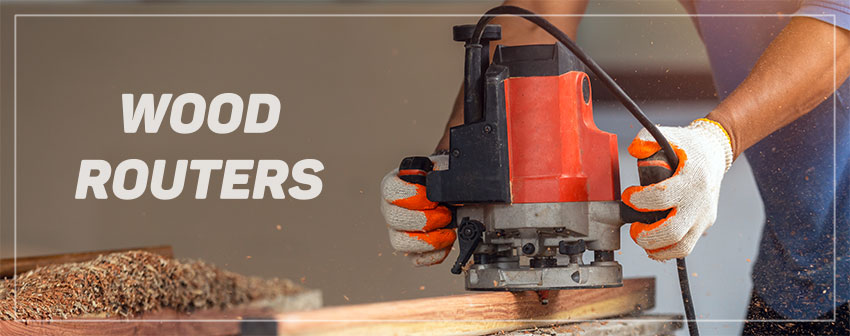
How to Pick the Best Wood Router?
There are many features that each wood routers have to offer. These are variable speed control, power, soft start, bit changing, cord length, handle design, and motor housing. There can be a lot to choose from. However, you can determine which of the features is most important and then look at each type of router to compare what additional features it may offer. The choices can be quite confusing. However, with a little bit of knowledge, hopefully you will have a better understanding and be more confident in your choice.
-
Horsepower (HP)
Wood routers can operate at many different horsepower. On average, the power can range anywhere from 1½ HP for palm or trim routers, to 2½ HP for mid-size routers, to 3½ HP for full-size routers or routers mounted on a router table or a CNC machine. Simple tasks do not require a larger horsepower to run and do the tasks that you need it to do. If you have a more difficult project or one with many cuts, you may need a wood router with a higher horsepower.
Some manufacturers only provide the revolutions per minute (RPM). To calculate the horsepower rating, use the voltage and the current rating, follow the below relation:
Current rating x Voltage rating / 746 = Horsepower.
-
Revolution per Minute (RPM) & Torque
Additionally, other than horsepower, torque and RPM are also useful attributes to know the capability of your router. Since horsepower only shows how much force the motor produces. However, it does not show the capability of cutting power. Torque measures the cutting force behind the bit which indicates the ability to cut materials of different hardness. Hardwood requires more torque than softwood. While RPM indicates the speed of the rotating bits. Generally, fast RPM leads to cleaner cuts, shapes, and is better for small bits. Slower RPM is better for big bits, removing large amounts of material, and when working with woods prone to burning or tearing-out.
For example, a router with a 2 horsepower motor with a speed of 10,000 RPM, produces 1.05 pound feet of torque. Which is the same amount of torque that a router produces with a 1.6 horsepower motor with a speed of 8,000 RPM. As a result, the two machines have the same cutting force. However, when these routers run at their maximum speeds of 25,000 RPM, the torque force would be 0.4 for the 2 HP motor and 0.3 for the 1.6 HP motor. To calculate the torque of your router, use the following relation:
5252 x Horsepower / RPM = Torque pound feet.
From the above relations, you will notice that torque increases with an increase in HP and torque decreases with an increase in RPM.
-
Amperage
The amps of a router can vary based on the base and the type of router you are choosing. Lower amps are used more for the lower horsepower routers while the higher amps are used for the higher horsepower routers. Further, by using a router at the highest available output for an extended period of time, you will risk burning out the motor. So, it’s a good idea to check the amperage rating.
If your work mostly require a handheld router tool for light-duty projects, then a light-weight 10 amp router will suffice. On the other hand, if you work requires a heavy-duty router tool for bigger projects or a router table, then a full-size 15 amp router is a better choice.
-
Corded & Cordless
Mid-size and full-size wood routers are usually electrically corded motors and they demonstrate their power capabilities in horsepower and sometimes by amperage ratings. However, for smaller routers such as palm, trim, and laminate routers they are also available in cordless models. For these battery-operated routers, they usually demonstrate their power capabilities in voltage ratings.
Manufacturers measure their battery life with amperage per hours (Ah), the higher the amp-hour rating, the longer running time between battery charges. Additionally, they sometimes point out the efficiency of these cordless models by giving an estimate of routing length per amperage hour. For example, a good cordless wood router can do a minimum of 20 feet of routing per amp-hour. And, when it comes to brushed or brushless motors, then brushless motors usually win the race. They run quieter and they save battery power for longer.
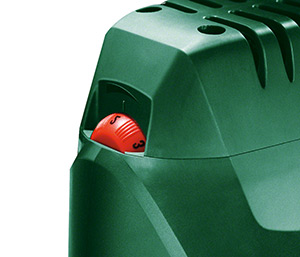
-
Variable Speed Control
This feature allows you to decide what speed your router will operate on for each different project. This can vary from the size of bit you are using to the kind of project you are working on. Most mid-size and full-size routers are equipped with variable speed control, and it helps if you use the same router tool for all your bit sizes. Not all bits perform well at the maximum speed. For example, if you are working on a project with a larger bits, you will want to operate your router at a lower speed so that you have more control over the cut and it is safer for you, and vice versa for smaller bits.
-
Soft Start
The soft start feature is more of a safety feature than anything. It starts your router out at a slower speed and increases slowly. This will keep your router from jerking to a full throttle start which is both safer for you and ensures you do not damage the wood you are working with. Soft start comes with most new wood routers that have electronic feedback circuitry.
-
Handle Design
The handle design will determine your comfort level when using a wood router. They come in several different sizes, shapes, and placements. Plunge routers usually have a handle that is up higher so that you have the right leverage to complete the deep cuts of your design. A fixed base with two knobs handle is better and allow for steady router movement. A D-handle base or a pistol grip actually allows for control with both hands and the power switch is easily accessible so that you can turn the router on or off without have to remove your hands from the router itself. The base can affect what type of handle design you are able to choose. However, there is usually a few different options for handles with each type of base.
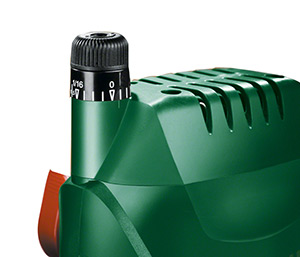
-
Cutting Depth
The maximum cutting depth is a function of the base design of your tool and it is usually under 2 inches in most plunge base and fixed base routers. Sometimes, plunge base routers offer a little more depth than a fixed base or stationary routers, this is due to their plunging action. Since you can run multiple passes to achieve the intended depth, you should not really consider the depth of cut. Specifically, if the difference between two models is less than half an inch.
However, the adjustment mechanism for depth is more important. The accuracy depends on the kind of work you will be doing. For example, working within 1/64th of an inch is fine for trimming the edges, cutting out dadoes, and rabbets. While a high level of accuracy such as 1/128th of an inch is better for complex jobs such as wood joinery. It all depends on the type of work you will be doing, look for models with levers or clamps on the side to simplify your job.
-
Collet Size
The collet of a router is essentially the neck that holds the router bit in. Routers typically come with a 1/2 (0.5) inch collet or a 1/4 (0.25) inch collet. Palm routers are usually limited to a 1/4 collet which can hold a bit that is 1/4 inch diameter. The downfall of a router with a 1/4 collet is that it cannot be changed. A 1/2 collet can hold a bit that is 1/2 inch diameter. However, since the collet is larger, it usually comes with an interchangeable collar. So, it can be changed out to a 1/4 collet which gives you more options. This could be a deciding factor when it comes to choosing the best router for woodworking.
-
Bit Changing System
Some woodworkers will work with the same bit for quite some time while others will work with a different bit several times throughout a project. For those who change bits more frequently, they may want a spindle lock system. This is not a very important feature to take into consideration when deciding on the best router tool. However, it’s particularly handy in plunge routers where it’s hard to remove the motor to get better access to the bits.
Without a spindle lock it would require you to use two wrenches for making bit changes. One wrench to hold the motor shaft and one wrench to loosen or tighten the collet. But, with a spindle lock, you only push a spring-loaded pin or engage a locking collar to hold the motor shaft in it’s place and only use one wrench for the collet.
-
Plastic or Metal Motor Housing
When it comes to repeated projects and higher horsepower, a metal motor housing would be ideal. The metal housing can stand up to the increase in speeds and longer running time and will have more durability. This reduces the wear and tear on your router. However, with the plastic housing, the router is more light weight and it is easier for you to handle. The durability is not the greatest though. This will be more of your preference on which is more important to you.
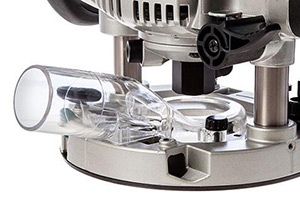
-
Extra Features
- Dust collection: it allows you to attach a hood dust collection system to a stationary router. It vacuums the wood dust bits that can fly off while the router is in use.
- LED work light: a small flash light that turns on when the router tool is engaged. It makes it clear to see the marks and points that you are trying to follow.
- Electronic circuitry: it increases or decreases the torque based on the load that the motor is handling. For difficult cuts, it will increase the torque, and for easier cuts it will decrease. It also adds to the lifetime of your router.
There are so many different options to choose from and so many different ways to look at them. Education is a key factor in determining what type of router to choose and how much money you have to spend on the router. Are you working with short cuts or long cuts? Are you going to be using the router frequently or just intermittently for smaller projects? Ask yourself these questions to help you figure out which router and features to choose.

Types of Wood Routers
A wood router can assist a wood worker in creating joints, intricate designs, route out the grooves, and so many other things. So how do you know what type of wood router to get? There are many different types of wood routers with different power capabilities and sizes that do so many different things. Which one is the best wood router for the money and for? Let’s start by telling you about each type of router and the benefits they can have. The choices can be overwhelming and that is okay. Just read through each type and keep in mind what you intend to use your wood router for.
-
Compact/Trim/Palm Routers
These compact wood routers allow for easy maneuvering with one hand. Palm and trim routers are a great choice for people who are just starting out with wood routing and they are more convenient. These small wood routers are lightweight and versatile, they allow the woodworker to travel with them and store them around the workshop easily. These portable wood routers usually run on 1 or 1.5 horsepower motors and most of them use 1/4 inch shank bits. However, despite their small size, they are still capable of working on relatively large work-pieces. They are not designed for heavy milling but they do well with fine joinery.
Palm and trim routers are quite versatile and you can use them for various applications such as edge forming, making joints, hinge mortising, slot cutouts, laminate trimming, decorative inlay projects, and small-scale dovetailing tasks. These routers generally cost less. Many experienced woodworkers own both a palm router and a base router. They utilize the palm router for smaller projects around the workshop or work site.
-
Mid-Size Wood Routers
The mid-size wood routers usually have over 1.5 to 2.5 horsepower engines and often they accept both 1/4 and 1/2 inch shank bits. Due to their versatility, they are the most popular. These mid-range wood routers open up a whole different set of capabilities.
They usually require two hands for operation but depending on the base different handles are available too. Apart from everything that you can do with a trim or a palm wood router, they can also do heavy milling, panel cutting, template design work, mortising, profile cuts, and large-scale dovetailing.
-
Large-Size Wood Routers
For professional woodworkers that are looking for a heavy-duty wood router, the full-size wood router is the best choice. These types are mostly aimed towards heavy production and industrial jobs. These heavy duty routers run on engines that are 3 horsepower and above. Due to their large and heavy design, they are mostly used with router tables or CNC machines. They are not designed for everyday handheld wood routing use. To learn more, check out our exclusive list of the best router tables.
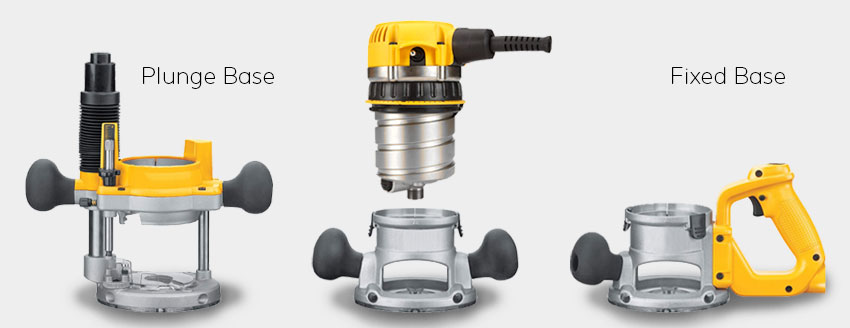
Base Types of Wood Routers
Now, after you got to learn everything about the different sizes and models of woodworking routers. Then, it’s time to learn more about the types of bases incorporated with such wood routers and their uses. As you can see, there are many different types of routers and many different options to choose from. Each of these wood routers has benefits for the type of woodwork that will doing. Having the knowledge of how each one can benefit you and what types of projects you will be working on can go a long way in choosing the right type of router for you. What experience level are you at with woodworking and wood routing? How much space do you have to store and work with your router?
-
Fixed Base Routers
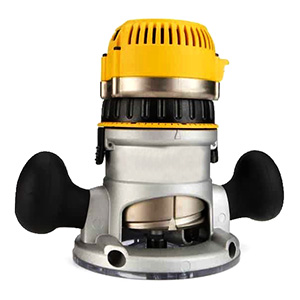
A fixed base router may be the best wood router for beginners, for someone who is starting with woodworking. Using it is rather easy and they preform almost 90% of all wood routers tasks. They work great with molding and edge cutting projects that need a straight line cut. They can also be mounted on a router table or a bench allowing them to be even easier to use with more stability. In addition, they are much lighter in weight and they usually cost less than plunge base routers.
With this device, it allows you the option to set the blade depth (which is not an option with a plunge router). Setting the depth will help keep your project from getting over cut or gouged. This can be a downfall if you need to cut different gouges or depths in the same piece of wood while doing a project. However, keep in mind that performing this type of cut is generally far beyond the beginner’s knowledge base.
A fixed base router is one where the base does not move. These routers are great because once you set it at a certain depth, it will stay as it is until you decide to change it. This way if you are completing a repeat project, it is already set up for you. Also, many projects that are similar will require the same depth, so it will save you the time of trying to set the depth. They can be used for general routing work, smoothing sharp points, shaping, molding, dovetail, box joint jigs, and edge cuts.
-
Plunge Base Routers
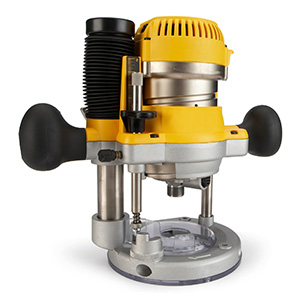
Plunge routers are better suited for those who have some experience or are working in a professional setting. It can do many tasks, including everything that a fixed base router does, plus operations that require the bit be plunged into the wood away from the edge. What’s great about plunge routers is that you can adjust your cut depth while it is in use. This is where they get the plunge name from. It can be plunged to different depths while the machine is in use by using the depth stop. This comes in handy when cutting grooves, mortises, incised letters, and more.
Plunge base routers are designed to move up and down on machined spring loaded columns. However, they are a bit more complicated to setup and they are typically more expensive than fixed routers. Additionally, since their handles are mounted higher, they are a little more difficult to control. None the less, with practice everything can be figured out. This type of woodworking router does have its downfalls. A fixed base table will not work with this router. Also, having that plunge effect to cut at different depths actually adds more weight to the tool.
You would be able to utilize a plunge router best if your work requires patterns, have deep wood grooves, through cuts, or uses templates. It can cut in the middle of the wood and you have more control over its movement. It is useful for increased durability, shaping without having to tilt, deeper cutting, and interior wood cuts. In addition, it does interior grooves, dovetailing, wood engraving, mortising, dado cuts, and deep cuts.
-
Interchangeable Router Kits
Interchangeable routers is essentially a fixed base router and a plunge base router combination. This type is the best wood router for professionals, it’s great for those who are experienced and work with different types of projects. Combination routers give you so many more options with what you can do. You can cut your straight lines with the fixed base and cut your templates with the plunge base. Purchasing this type of wood router tool, is also cheaper than buying both machines separately. However, it does have a downfall. If you are a frequent user of each type of router, you will be changing bases very frequently. This can become tiresome but could be worth the extra effort for many users.
It has the most versatility, is more cost effective, and is one tool that can be diverse in all of the aspects of wood routing. It can do interior cuts, interior grooves, dovetailing, engraving, deep cuts, through cuts, general routing work, smoothing of sharp points, shaping, edging, and more.
What is a Woodworking Router?
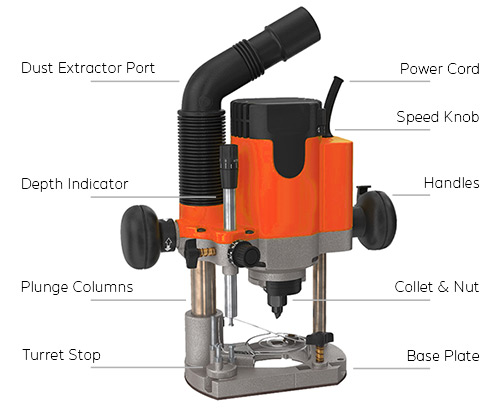
The simple answer to this question is that it is a tool used by woodworkers to hollow out parts of wood in different shapes and sizes to create a design or edge. It can be bought in two different types. These are fastened to a router table or as a handheld router.
It is considered by many woodworkers as the most versatile tool in their workshop. It can cut, trim, and shape wood at a high level of speed. You can use it for edging, cutting, and working with patterns. Using a handheld router, can be moved easily across the wood or throughout the workshop.
How Does a Router Work?
A router is usually air driven or electric driven. It has a tool known as a router bit that actually cuts the wood and has a guide template to help guide the material to prevent mistakes and injuries. Routers can be handheld or fixed to a base of some sort. A base router is considered more stable and safer than a handheld router.
What about Router Bits?
The router bits are the part that does all the cutting and acts as the contact point with the workpiece. There are three different types of bits used for cutting in a router. Each bit has a different use. For trim and edges there is fluted cutters. For trim and shaping there is profile cutters. And, for trim, shaping, and drilling, there is helical cutters.
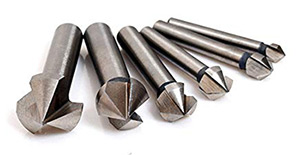
What are the Types of Router Bits?
Router bits come in many different sizes and types that can provide different effects for your woodworking project. Each bit has a classification. It can be either HSS (high speed steel) or carbide-tipped. Carbide-tipped bits offer more advanced and specialized cuts than HSS bits. They are also made in two different classifications. These are non-edge bits and edge bits. A non-edge bit will require that a fence be used in order to prevent the bit from going to deeply into the wood causing a kick back which can cause injury or damage the wood. An edge bit has its own fence built in in the form of a wheel bearing.
What about Router Safety?
It is always important to wear the proper safety gear (PPE) when it comes to using any power equipment. You will want safety glasses, gloves, and ear plugs. When using a router, even with the dust collector, wood bits come out of the wood at high speeds and can cause injuries. Wearing your safety glasses can avoid eye injuries. Wearing your ear plugs can avoid damage to your ears and ear drums from the loud sounds that can happen while drilling through hard wood with your router.
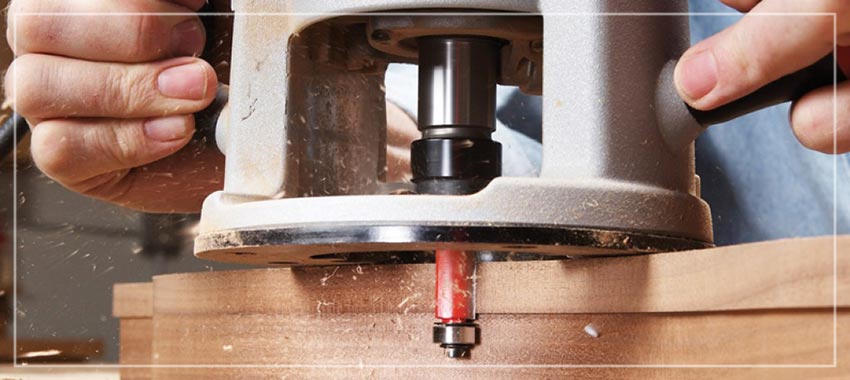
Benefits of a Woodworking Router
Many people think that all a wood router does is cut those fancy edges they see on woodwork. It can do so much more. It can cut patterns, rabbets, dadoes, and more. Keep reading to learn how all of this can be done with a simple wood router.
If you are creating cupboards, drawers, hinges, or other things that would require a groove or rebate, a wood router is a perfect tool. It can create grooves, such as the tongue and groove technique to help wood pieces interlock.
-
Routing Edges & Trim
When working with trim or finishing the edges on a project, a router can make sure that the wood sits flush with the next piece or has a clean edge in whatever bit design you choose. This type of task used to be done with a file and since the creation of the router, it has been easier and more accurate to combine two pieces of wood and created beautifully finished pieces.
-
Creating Joints
The days of creating joints in a wood project with a chisel and saw are over. The wood router has different bits that you can use in order to create joints in pieces of wood to allow them to interlock together like puzzle pieces. It is now faster and more accurate to use a wood router for this type of project.
-
Molding & Beading
There are bits available that will assist you in creating nice molds or beads around the edges of trim. You see cuts like these in moulding such as crown molding around a home. The designs that are in the molding are created with a wood router. The smaller pieces of trim that seem like they were made to specifically sit in the corner with the curve facing inward were created with a specific trim bit and a router.
-
Routing Holes
A plunge router allows a woodworker to cut a hole such as that of a drill press. Using the different bits the holes can be created in different sizes, designs, and depths. The depth can be monitored so that the bit doesn’t go all the way through the wood if that is what the project calls for.
A wood router can be used for many types of projects and create many different types of cuts and grooves in wood projects. The best handheld router can be chosen by understanding exactly how a wood router works and what it can do.
Bottom Line
Finding the best wood router is not an easy task. However, with our woodworking router reviews, we hope that you see the many different features a router can have and you find the right wood router to use. Features such as cordless, attachable rails, plunge based, fixed based, combination routers, and more can be the key to what your project needs. When looking for the best woodworking router to use for your projects, keep in mind projects you may be doing down the road. Decide what kind of horsepower you need and what kind of voltage you will have available when working will help you in narrowing down the top rated wood routers most suitable for you.

